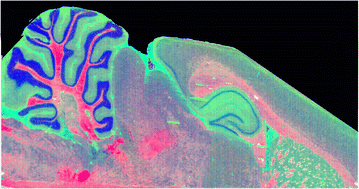Association between ageing, brain chemistry and white matter volume revealed with complementary MRI and FTIR brain imaging†
Abstract
Magnetic resonance imaging (MRI) is the gold standard method to study brain anatomy in vivo. Using MRI, subtle alterations to white matter structures in the brain are observed prior to cognitive decline associated with the ageing process, and neurodegenerative diseases such as Alzheimer's disease. Detection of such alterations provides hope for early clinical diagnosis. While MRI is essential to detect subtle alterations to brain structure in vivo, the technique is less suited to study and image the distribution of biochemical markers within specific brain structures. Consequently, the chemical changes that drive, or are associated with MRI-detectable alterations to white matter are not well understood. Herein, we describe (to the best of our knowledge) the first application of a complementary imaging approach that incorporates in vivo MRI with ex vivo Fourier transform infrared (FTIR) spectroscopic imaging on the same brain tissue. The combined workflow is used to detect and associate markers of altered biochemistry (FTIR) with anatomical changes to brain white matter (MRI). We have applied this combination of techniques to the senescence accelerated murine prone strain 8 (SAMP8) mouse model (n = 6 animals in each group, analysed across two ageing time points, 6 and 12 months). The results have demonstrated alterations to lipid composition and markers of disturbed metabolism during ageing are associated with loss of white matter volume.



 Please wait while we load your content...
Please wait while we load your content...